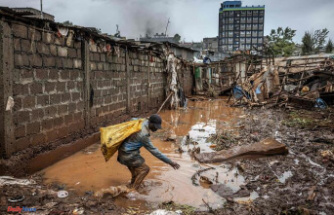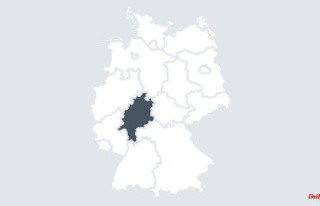Straw bale construction has been around since the end of the 19th century. But for a long time he was not very popular. Straw bales as insulating material are cheap, sustainable and of high quality in terms of energy.
Kassel/Bad König (dpa/lhe) - For Christoph Harney, straw is one of the building materials of the future. "It is a by-product of grain cultivation, grows very quickly compared to other sustainable building materials and is available in large quantities," explains the architect. 20 million tons of straw are harvested in Germany every year. "About 20 percent of it, and thus four million tons, are not needed and are simply left over." Harney is currently installing part of it in an apartment building in Kassel.
The walls of the building's penthouse are insulated with straw bales. 250 pieces have been pressed into the compartment. The outer walls are plastered with lime, the inner walls with clay. Wall heating is also integrated. Harney can allay worries about moisture or pest infestation. "If installed properly, the straw will not rot and will not be infested by rodents and vermin," he explains. It also has very good fire protection properties.
The finished assembly systems made of wood and straw were supplied by a company from Taucha in Saxony. A company from Göttingen tested and certified the construction straw for moisture and compression, among other things. "The straw is untreated, we even have organic quality here," emphasizes Harney.
Straw bale construction is particularly good for the climate: "The straw stores carbon dioxide during growth and for the life of the house," explains Harney. Compared to other thermal insulation materials, the production of the bales resulted in minimal CO2 emissions. In addition, straw bale houses have a very good insulation value. "The bales are a good heat storage and help to save additional heating costs," explains Harney.
"If we really want to be climate-neutral in a few years, we have to rely on renewable building materials," says Holger Zimmer from the Hessen Chamber of Architects and Urban Planners. Straw bales are an important component. Manufacturing a straw bale house saves so much energy that it can heat a house for 70 years. In addition, Keller sees savings potential for builders, because with straw bale construction, with a little knowledge and guidance, you can do a lot yourself and save money. His conclusion: "The construction method is wrongly completely underestimated."
The architect attributes this primarily to a lack of awareness of ecological building materials. "We have been introduced to synthetic industrial building materials far too much over the years." You could just as easily build a house with straw, "but the building sector is conservative." A rethink is urgently needed. "In order to conserve resources and make us independent of imported materials, we have to rely on renewable raw materials," explains Zimmer.
"Straw is an important part of the construction revolution," agrees Adina Lange from the German straw bale construction association. It is estimated that there are currently more than 1,000 straw houses in Germany. About 50 are added every year. "Straw bale construction is picking up speed," says the construction engineer and carpenter. She would like more knowledge to be conveyed about this type of construction.
"More education is needed about the irrevocable advantages of straw bale construction and more training," agrees Holger Zimmer. The architect is confident that straw will continue to gain popularity as a building material. "On the one hand, sustainable building will be more strongly promoted by law in the future. On the other hand, everyone will be thinking about how they can save energy costs at the latest when the next bill is issued."
The architects Susanne Körner and Tilman Schäberle from Bad König in the Odenwald district are pioneers of straw bale construction in Hesse. In 2005, they erected the first office building in Darmstadt made of straw bales. In 2008 the first residential building followed in Bad König, which they live in themselves. Around 750 pressed straw bales from the region were used for the complete thermal insulation of the 260 square meter house.
More than ten years later, Körner is still enthusiastic. "Straw bales are the most sustainable insulation material. They are climate-neutral, locally available, offer good thermal insulation in summer and good insulation values for the outer wall in winter," she explains. In addition, unlike conventional insulating materials such as Styrofoam, straw can be disposed of in the compost after dismantling without any problems. Unfortunately, sustainable construction techniques have been neglected for a long time, says Körner. Luckily, interest is now growing.
The straw bales were also convincing in Kassel. In the first of three construction phases, he initially only tested the bales in the attic, reports Christoph Harney. "We have had good experiences with this and are therefore planning to build the other two construction phases entirely with straw bales."
In straw bale construction he sees an opportunity to create more affordable and climate-friendly apartments. On average, ten tons of straw are needed to insulate a residential unit. "With four million tons of straw left over as a by-product, that makes 400,000 residential units," he calculates. "Enough for the 400,000 apartments that the federal government wants to build every year."












